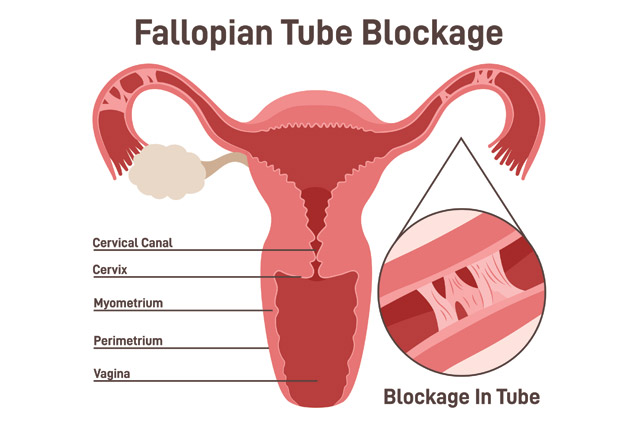The CDC says that 19% of women of childbearing age struggle with infertility. Of this number, around 25 – 30% cannot conceive because of the tubal infertility, which is the inability to conceive due to the blocked fallopian tubes. We’ll revise the possible reasons for this type of female infertility as well as evaluate the chances of getting pregnant for women who will go through one of the possible methods of tubal infertility treatment.
What Should You Know about the Fallopian Tubes?
Fallopian or uterine tubes appear like narrow channels joining the ovaries with the uterus. They are one of the essential elements of the female reproductive system. The main function of this organ is to help the ovum released during the ovulation make its way to the womb. Also,this organ is the place where the egg and sperm meet to create a new life.
Among the causes of obstructions interfering with your ability to conceive, there are:
- the scar tissue resulting from pelvic surgery;
- sexually transmitted diseases, especially gonorrhea or chlamydia;
- endometriosis;
- pelvic infections;
- tubal ligation;
- congenital abnormalities.
How Are Tubal Blockage and Infertility Connected?
Once any tubal obstructions appear, the uterine tubes cannot perform their normal function. This means there are two possible scenarios of the fertility problem development.
The first one is the egg from the ovaries does get into the fallopian tube, but the egg and sperm cannot join, as the latter cannot get through the obstructed channels. Therefore, impregnation is impossible.
The second scenario is the sperm reaches the ovum, but the fertilized egg is unable to get to the womb. If this happens, the embryo implants right in the tube, and an ectopic pregnancy starts developing. This is a life-threatening condition, which may cause a tubal rupture with the following loss of the organ.
What Are the Symptoms?
A lot of women hope to know about the problem just by figuring out the possible symptoms. However, in this case, it is almost impossible to determine the problem without undergoing a special test. The only symptom that may possibly point to the problem of tubal infertility is pelvic pain. It usually concentrates in one side of the lower abdomen and may either be chronic or appear during your period.
So how can you know you have a tubal blockage? Generally, your OB-GYN may recommend checking the patency of the fallopian tubes if you haven’t succeeded in conceiving within a year of trying for a baby. The test may be advised earlier if you have at least one of the listed factors that might have provoked the appearance of the blockage.
The test we are talking about is called hysterosalpingography. In simple words, it’s an X-ray with a contrast agent aimed to define any obstructions in the female reproductive system that may interfere with fertilization.Based on the outcomes of the test, your healthcare provider will suggest choosing one of the two fertility treatments applied in such cases.
How to Treat Tubal Obstruction?
If the test shows your fallopian tubes are blocked, your fertility specialist can offer such options:
- Tubal surgery. The removal of occlusion and restoration of the patency of the tube can be made with several surgical methods. The extent of intervention (open abdominal or laparoscopic surgery) and the type of surgery are selected individually based on the location of the obstruction and its severity. The chances that you’ll recover your fertility after the tubal surgery reach 60% maximum if the blockage is closer to the uterus. The further in the tube it goes, the lower your chances for natural conception.
- In-vitro fertilization (IVF). The alternative or additional way of impregnation is via IVF treatment. This kind of therapy is offered to women whose possibility of natural conception is extremely low. This category comprises patients whose occlusion is closer to the ovaries and those suffering from certain types of complications related to the poor patency of the tubes. The thing is that in such a situation, the obstruction may prevent the egg from entering the uterine tube, making fertilization impossible.
In specific cases, a woman may need to undergo both surgical and IVF treatment. The former should be made to increase the chances for success for the latter.
The combination of treatment methods is advised in women whose tubal obstructions caused the condition called hydrosalpinx. It is characterized by the accumulation of fluid in the fallopian tube. Hydrosalpinx significantly lowers the success rates for pregnancy resulting from IVF.
Steps to Getting Pregnant
The amount of information to process is huge, so it is no surprise that some women may get at a loss and don’t understand the algorithm of their actions in tubal factor infertility treatment. To simplify this task and give you the roadmap you can use, we’ve compressed all that into 7 steps you should take.
Step 1. Check for any reasons of infertility not related to the tubal blockage
If there has been a year since you’ve started attempting for a baby and there’s been no success, make an appointment with your OB-GYN to check for any reasons for infertility. These include the absence of ovulation (irregular periods), hormonal imbalance, uterus abnormalities, and others.
In case your doctor doesn’t see any reasons for your inability to conceive, move to the following step.
Step 2. Make an appointment with a fertility specialist
Meeting with a fertility specialist is essential for proper infertility diagnostics. Besides, a specialist in the sphere will later help you work out the treatment tactic and increase your chances for success to the maximum.
Step 3. Pass a test for the tubal patency
You’ll likely be offered to pass hysterosalpingography – the test we’ve mentioned earlier. You may need some time to get ready for a test. It is also important that you don’t have any contraindications to undergoing the procedure, like ongoing pelvic infection or allergy to the contrast.
Step 4. Understanding the diagnosis and its cause
Based on the results of the test, your doctor will determine if there are any tubal obstructions. Also, it’s essential that you know the cause of the blockage. Not only will this help you pick the best treatment option but will also help you understand the risk of relapse in the post-treatment period. For instance, a blockage caused by scar tissue may appear again after a while. The same is true for the blockages caused by endometriosis.
Step 5. Considering the methods of treatment
On evaluating your medical condition, a doctor will be able to offer you the method of treatment that may be most effective in your case. You should also understand that there is no 100% guarantee of success. You may be offered several options. Take your time and think over the benefits and risks.
Step 6. Choose the treatment option
Because in-vitro fertilization involves the fertilization of several eggs, with only one or two, transitioned to the uterus, some women consider this method of infertility treatment unacceptable. Choose the option you feel fine with but, please, take into account your doctor’s recommendations.
Step 7. Complete the treatment
Undergoing tubal surgery or IVF is the final step on the way to parenthood for many women struggling to conceive. But keep in mind that there’s always a risk of failure. You have to be ready physically and mentally that this is only the beginning of the journey. Still, the chances for success are really high, so we hope this step will end with a healthy pregnancy and the birth of your long-awaited baby.
Pregnant with Blocked Fallopian Tubes – Final Words
Millions of women around the globe struggle to get pregnant.After years of failure, some of them may find out they have tubal factor infertility. While it may sound like a sentence at first, you should know that it’snot, and there is treatment. Good luck!




